| Lot |
Photo |
Description |
Realized |
Lot 440 |
 |
9.5 INCH SPHENODISCUS AMMONITE. This complete 9.5 inch large 90 million year old ammonite Sphenodiscus lenticularis was found in Montana and was fossilized when the large inland sea submerged much of Montana. Ammonites were like armored squid that became extinct 65 million years ago at the same time as the dinosaurs. This beautiful example still has some of its original mother-of-pearl which has fossilized from brown to an iridescent red color. These colors are so prized that gemstones are made from them called ammolite. Interesting suture patterns (strengthened the shell) show where the mother-of-pearl has worn off. This large heavy ammonite sits upright against a solid stone matrix making for an excellent display or even for use as a book-end.
Add $30 for domestic shipping.
Estimated Value $400 - 600.
View details and enlarged photo
| Unsold |
Lot 441 |
 |
97 MILLION YEAR OLD GUITAR FISH. This extremely large 18.5 x 3 inch long Guitar fish, Rhinobatos hakelensis is 97 million years old from the sublithographic limestone deposits of Haqel, Lebanon. A Guitarfish is a ray that is quite primitive and has characteristics of both a shark and a skate. They are bottom feeders with small crushing teeth and fed on crabs and clams. Being cartilaginous they rarely fossilize but this attractive near complete brown specimen is the exception. The two small dorsal fins are present as well as the tooth pavement with some teeth extending outwards from both sides of the tooth pavement which extends back from the tip of the snout towards the two small eyes. This impressive fossil ray has nicely contrasting light and dark brown color on the 21.5 x 5.25 inch light tan limestone matrix.
Add $60 for domestic shipping.
Estimated Value $1,500 - 2,000.
View details and enlarged photo
| Unsold |
Lot 442 |
 |
AQUATIC 150 MILLION YEAR OLD REPTILE. Sinohydrosaurus lingyuanensisgen was a strange looking aquatic reptile with a very long neck that lived 150 million years ago in fresh water lakes in Liaoning Province, China. Sinohydrosaurus translates to Chinese water dragon. This specimen is quite large at 15 inches and virtually complete (missing only a few digits in the feet) with all four legs, tiny rib bones and even smaller gastralia rib bones and most importantly an excellently detailed skull with several small sharp teeth visible. The 17 x 6.5 inch matrix of soft tuffaceous volcanic rock (hardened from the volcanic ash that buried this reptile) has been nicely smoothed and backed for stability as the tuffaceous rock is very soft. Sinohydrosaurus may be an ancient relative of the fierce Komodo Dragon and museum quality specimens such as this one are becoming very difficult to locate.
Add $30 for domestic shipping.
Estimated Value $600 - 800.
View details and enlarged photo
| Realized
$588 |
Lot 443 |
 |
CARCHARODONTOSAURUS DINOSAUR TOOTH. Huge 4.12 inch long by 1.75 inch wide complete dinosaur tooth of Carcharodontosaurus saharicus, the T-Rex of Africa. Even though Carcharodontosaurus was even larger that a T-Rex, most of the teeth found are only 1.5 to 2.5 inches long. This excellent brown tooth was found in two pieces which fit together exactly with only minor repair to the very end of the tip. It is not only long and wide but also has most of its enamel present with only minor enamel chipping which almost always occurs. The steak knife-like serrations are sharp and present on both edges of the tooth with only minor breaks. This very large impressive tooth was found in the Sahara desert of Morocco and Carcharodontosaurus was older than a T-Rex at 70-80 million years old. Housed in a 8 x 6 inch Riker mount.
Add $15 for domestic shipping.
Estimated Value $800 - 1,000.
View details and enlarged photo
| Unsold |
Lot 444 |
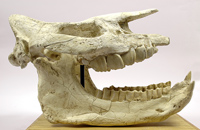 |
CHILOTHERIUM RHINO SKULL. This huge virtually complete skull comes from a very strange looking early 15 million year old rhino, Chilotherium, from Fugu, Shanxi Province of Central Asia. The upper skull measures 19.5/ x 8.5 inches and has been professionally prepared out of its stone matrix. The white bone quality is excellent with some dark brown matrix still attached for stability. There are twelve very large teeth in the skull, the largest being 2 x 1.5 inches. The lower jaw was missing and has been cast from a complete similar sized specimen and perfectly matched color and texture with the museum quality skull.
Chilotherium was a huge early rhino that looked somewhat like a cross between a rhino and a hippo. It had a barrel shaped body with short legs like a hippo (possibly aquatic) but a very rhino-like face and head with two strange knob shaped horns made out of hair like a rhino and two tusk teeth in the bottom jaw. An impressively mounted huge fossil skull free standing on a custom wooden base.
Add $100 for domestic shipping.
Estimated Value $3,000 - 4,000.
View details and enlarged photo
| Unsold |
Lot 445 |
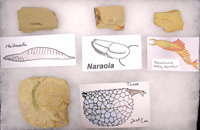 |
COLLECTION OF THE VERY FIRST CAMBRIAN ANIMALS. The 525 million year old fossils of Chengjiang are very important as being the earliest and best preserved of the early Cambrian fossils being 15 million years older than the famous Burgess Shale of Canada. Many types of small weird soft bodied animals are found at Chengjiang and this collection contains four of the most famous. Haikouella was one of the earliest chordates which are the earliest ancestors of the vertebrates. This small swimming animal was only about one inch long but had a head, gills, brain, notochord, heart and circulatory system and perhaps even small eyes. This specimen is 20mm long and shows the gill slits which covered most of their body. Naraoia, a trilobitomorph, is represented by a virtually complete 7mm long specimen that clearly shoes its two body shield sections which separates it from trilobites which had three sections. Anomalocaris was the top predator of the early Cambrian and grew to over three feet in length but usually only the feeding appendages are found because they were the only part of its body that was scelotized (strengthened). This 16mm appendage is typical in looking like a shrimp with legs which is what early paleontologists thought it was. Lastly is a near complete specimen of the bivalve shell(50 x 35mm) of Tuxioa which was a strange looking arthropod with its entire body except for its antennae and tail covered with an ornamented bivalve shell. This unusual grouping is a rare opportunity to study multiple fossils from the earliest site of the Cambrian explosion. This important grouping is housed in a 12 x 8 inch Riker mount for display.
Add $15 for domestic shipping.
Estimated Value $650 - 850.
View details and enlarged photo
| Unsold |
Lot 446 |
 |
COMPLETE SABER TOOTH WITH ROOT. This complete 7.5 inch Saber tooth with a complete root is from the largest Saber toothed cat that ever lived, Machairodus giganteus which roamed the Gansu Province of Central Asia 6-10 million years ago. It was larger and far more massive than its more famous cousin, Smilodon although Smilodon had larger but thinner teeth. This scimitar shaped tooth with root is evenly divided with a 3.75 inch serrated tooth and a 3.75 inch root. The enameled tooth is slightly darker in color that the white root and has small serrations while the root has none. In the skull, about one inch of the root would also extend above the jaw making the tooth 4.75 inches long. Saber toothed cats being mammals had to be very careful with their teeth because they could not be replaced if they were broken which would result in the animal dying. That means that they could not bite through solid bone like a T-Rex could or these sharp lethal but delicate teeth would break. Some Saber toothed cats like Smilodon lived with early humans and a smaller complete Saber tooth with root was made into a pendant by Neanderthals some 30,000-40,000 years ago.
Add $15 for domestic shipping.
Estimated Value $1,200 - 1,500.
View details and enlarged photo
| Unsold |
Lot 447 |
 |
COMPLETE STARFISH AND CARPOID. Complete starfish are rarely encountered in the fossil record as their arms tend to become disarticulated when they are buried. Fortunately, some of the best preserved fossil starfish and also some of the oldest are found in the Kataoua formation (475-490 million years old) near Mecissi, Morocco. This 12 x 10 inch plate contains a complete 3 inch long orange brittle starfish as well as a strange looking animal known as carpoid which was an extinct relative of starfish and crinoids. This 5 inch long orange echinoderm is preserved in a free swimming position (looking somewhat like a snail with a large antennae) with its single filter feeding arm in front, the plated body and the flexible tail well preserved. The single 1.5 inch feeding arm was used in gathering small animals and floating detritus in the water. The contrast of the orange starfish and carpoid with the brownish-gray matrix makes for an excellent display.
Add $15 for domestic shipping.
Estimated Value $400 - 500.
View details and enlarged photo
| Realized
$353 |
Lot 448 |
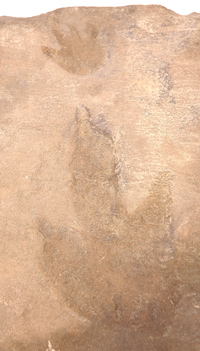 |
DINOSAUR AND CROCODYLOMORPH FOOTPRINTS. Unlike fossil bones footprints preserve an exact moment in time. This 9 x 7.5 inch 200 million year old sandstone block preserves not only a 5.5 x 3.5 inch Anchisauripus theropod dinosaur track but also a smaller 2 x 1.75 inch crocodylomorph reptile foot print. An image appears of a fairly large unidentified meat eating dinosaur stalking a smaller bipedal crocodile type reptile on the wet mud of a drying up lakebed in the Shuttle Meadow Formation of Connecticut. Both prints are the negative actual tracks in the soft mud with the much heavier three toed dinosaur footprint being deeper with two sharp claw prints visible and the crocodylomorph footprint more shallow and having five toes.
Add $20 for domestic shipping.
Estimated Value $350 - 450.
View details and enlarged photo
| Realized
$329 |
Lot 449 |
 |
DINOSAUR EGG MUSEUM QUALITY. This museum quality complete unhatched Duckbill dinosaur egg is 70-80 million years old 6.5 x 5.5 inches (the largest of the Duckbill dinosaur eggs) and of museum quality with over 95 percent of its original shell intact(where exposed). The egg is completely original and has a brown shell with only a touch of matrix still covering some of the shell. We do not know what Duckbill species this egg belongs to, but being the largest Duckbill egg it might belong to the huge Duckbill dinosaur Shantungosaurus which reached more than 50 feet in length and has been found in the same area in Henan Province of China. This museum quality dino egg makes an excellent display still standing on a small section of its reddish brown limestone matrix.
Add $20 for domestic shipping.
Estimated Value $600 - 800.
View details and enlarged photo
| Realized
$558 |
Lot 450 |
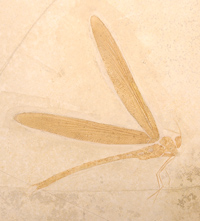 |
DRAGONFLY FROM SOLNHOFEN. Solnhofen Germany is well known for having the first bird found in the fossil record, Archaeopterix but one of its other famous and popular fossils is the dragonfly. These 150 million year old dragonflies are beautifully preserved in the fine grain lithographic limestone matrix. This rare species Protolindenia wittei is one of the largest and most dramatic. Perfectly positioned on a 7.5 X 6.5 inch limestone matrix, this huge dragonfly has a 4 inch long body and each wing is 3 inches long. The head, antennae, three legs, body ending in two hooks, and amazing wing detail where even the most delicate wing membranes are preserved make this dragonfly one of the finest to be found from the famous lithographic limestone quarry of Solnhofen.
Add $15 for domestic shipping.
Estimated Value $800 - 1,000.
View details and enlarged photo
| Realized
$1,028 |
Lot 451 |
 |
HUGE 17 INCH DIPLOMYSTUS. Some of the best preserved fish in the fossil record are found in the 50-52 million year old Green River Wyoming fossil fresh water lake beds. The vast majority of the fish found are small measuring only 2-4 inches long. This museum quality lot is the exception with a huge 17 inch long (close to the maximum size) Diplomystus which was an extinct member of the herring family. The huge fish is complete with outstanding skin, fins and even some sharp little teeth in its distinctive upturned mouth which enabled it to feed on small fish and creatures near the surface of the lake. The dark brown fish is nicely contrasted on the cream colored 28x18 inch sandstone matrix. This museum quality fish has been framed with a dark brown frame and is ready to be hung if so desired (hooks attached on back) although it can be displayed just as is.
Add $65 for domestic shipping.
Estimated Value $800 - 1,000.
View details and enlarged photo
| Unsold |
Lot 452 |
 |
HUGE ABERRANT AMMONITE. Most ammonites have the familiar tight spiral shape that is so familiar, but some ammonites known as aberrant ammonites began to straighten out forming a variety of odd interesting shapes. Why this happened after more than 200 million years of having only the spiral shape is unknown, but some species did change 70-120 million years ago. This huge 13 x 7 inch dark brown ammonite, Ancyloceras, is a perfect example of an aberrant ammonite looking something like a saxophone. It is 110 million years old and was found in the Atlas mountains of Southern Morocco. It is particularly large at 13 inches (most specimens are between 4-7 inches long) and very well preserved with its curved dark brown living chamber (the tentacled animal lived in only the last chamber) showing excellent detail. Only the initial small chambers at the other end are either missing or still contained in the matrix still remaining for stability. This large and spectacular ammonite would be the perfect specimen of the aberrant type.
Add $30 for domestic shipping.
Estimated Value $550 - 650.
View details and enlarged photo
| Unsold |
Lot 453 |
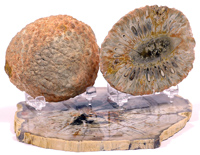 |
JURASSIC PINE CONE AND WOOD. This exquisite large 3.4 x 2.7 inch 160 million year old pine cone from Patagonia, Argentina has been cut in half and polished to reveal the inner beauty of the silicified seed kernels fossilized intact within. The inner core is light brown and the seeds and outer areas range in several hues from beige to orange. The outer surface of the pine cone has also been preserved with excellent detail. This rare preservation came from some giant over 100 feet tall) Araucaria mirabilis pine trees that were buried under volcanic ash over 160 million years ago. A matching beige with hints of orange 5.5 x 5.3 inch polished section of this Araucaria pine is also included. There is great demand for these beautiful pine cones as the site has been closed to collectors.
Add $15 for domestic shipping.
Estimated Value $450 - 550.
View details and enlarged photo
| Realized
$447 |
Lot 454 |
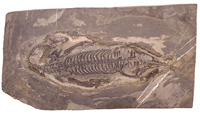 |
KUEICHOUSAURUS SKELETON. Kueichousaurus hui was the 240 million year old ancestor from Guizhou Province, China of the famous long necked sea reptiles Plesiosaurus which was made famous as being the mysterious Loch Ness monster. Kueichousaurus also lived in the ocean and had a long, flexible neck, tiny sharp teeth, webbed feet and a tail as long as its neck. This 8.5 inch long excellent 3-D fossil (an adult) has well defined bones and an excellent skull with even three of the small pointed black teeth preserved and is well positioned on a 8.5 x 4.5 inch dark grey slate matrix. All of the bones present are of top quality with even the smaller gastralia ribs visible beneath the larger ribs. All four legs are present but the toe bones are either missing or disarticulated and the end of the tail is missing.
Add $20 for domestic shipping.
Estimated Value $500 - 750.
View details and enlarged photo
| Unsold |
Lot 455 |
 |
MERYCOIDON MAMMAL SKULL WITH LEG AND HOOF BONES. Merycoidon was a strange 30 million year old mammal from the extinct oreodont mammal group that has no modern relatives and had some features of a pig and some features of a deer. This original limestone block is 14 x 10 inches and contains a 8 x 6 inch skull that is nearly complete with an excellent upper skull with most of the teeth present on both sides with one nice incisor that is sharp and somewhat pig-like and one complete lower jaw with most teeth and the other side of the lower jaw still mostly buried in the matrix. In addition there are several bones of one of the legs ending in two partial hooves and also several vertebrae from the neck. This is a completely original fossil block with the skull have a few cracks in it as found on privately owned land in the White River Badlands formation of South Dakota.
Add $35 for domestic shipping.
Estimated Value $800 - 1,000.
View details and enlarged photo
| Unsold |
Lot 456 |
 |
NEST OF FOUR OVIRAPTOR EGGS. Oviraptors were strange looking theropod dinosaurs toothless with a strong beak and most interestingly found to sit on their eggs like birds until they hatched. The name Oviraptor means egg stealer and they were misnamed this in 1920 when they were first discovered because it was believed they were eating the eggs they were found with instead of sitting on them. The four eggs in this partial nest are 6.5 x 3 inches in a 10 x 10 inch red limestone matrix. The two best of the fully exposed eggs have between 80-90 % of their original grayish black egg shell with the third exposed egg containing about 60% original shell. The fourth egg is still 75% buried in the matrix under the best top two eggs. Oviraptors laid their eggs in two layers one on top of the other as this partially buried egg illustrates. There are at least three species of Oviraptors and they can only be identified by the size of their eggs.
Add $40 for domestic shipping.
Estimated Value $1,700 - 2,200.
View details and enlarged photo
| Unsold |
Lot 457 |
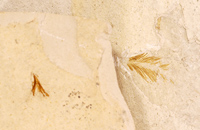 |
PAIR OF DINOSAUR FEATHERS. At 125-135 million years old these two possible dinosaur feathers are some of the oldest feathers know exceeded in age only by the 150 million year old Archaeopterix bird feather from Solnhofen. One of these feathers, 13mm long is symmetric which means that it is not a flight feather such as those found on birds. Most of the center rachis is still covered by matrix but there is remarkable detail showing delicate veining of the individual barbs. The second feather is a 7mm long protofeather that is found on the most primitive of the feathered dinosaurs. It is most likely a body feather that has a very small thin center rachis and extemely small thin curved feathers radiating outward in every direction. They were found in a fossilized volcanic lake bed in Liaoning in Northeastern China, the sight where many types of feathered dinosaurs have been discovered. Although it is impossible to distinguish between bird and dinosaur feathers, the only flightless animals found in Liaoning have been theropod dinosaurs so the probability is great that these are indeed dinosaur feathers. These valuable and rare feathers are housed in a 8 x 6.5 inch Riker mount.
Add $15 for domestic shipping.
Estimated Value $500 - 750.
View details and enlarged photo
| Unsold |
Lot 458 |
 |
PREMIUM QUALITY OVIRAPTOR EGG. This original Oviraptor egg is 70-80 million years old from the Djadokhta formation of Ukhaa Tolgod of Mongolia. This egg was found in the Gobi desert and is 7.5 inches long and belongs to the largest of the two Oviraptor species called Citipati to distinguish this difference from the other smaller species. Citipati Oviraptorids were made famous by the nest of eggs with the mother Citipati sitting on top of the eggs in a brooding position. This famous specimen is displayed in the New York Museum of Natural History and was discovered in 1995. It was revolutionary to discover a dinosaur sitting on top of its eggs like a bird and only later was it discovered that Oviraptors such as Citipati also had feathers like a bird. Citipati eggs are ratite in texture and have a very thin shell which is why they are rarely found complete. This premium quality egg has sharp textured detail on the shell and has about 90% original shell on the top side and 40% shell on the bottom side. The egg has not been fully airbrushed and still has some of the red limestone matrix on top of the dark brown shell. There are probably three or more species of Oviraptor type dinosaurs that had eggs that vary in size from 5-7.5 inches, but this classic egg definitely belongs to the species of Oviraptor, Citipati first found in the 1920s in Mongolia.
Add $15 for domestic shipping.
Estimated Value $600 - 800.
View details and enlarged photo
| Unsold |
Lot 459 |
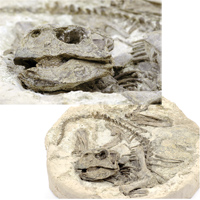 |
PSITTACOSAURUS DINOSAUR IN MATRIX. Psittacosaurus is a very important dinosaur that lived between 120-130 million years ago in Liaoning Province, Central Asia. Psittacosaurus is important as being the oldest ancestor of the famous horned dinosaurs such as Triceratops as well as having some type of quill type feathers on its tail. This is extremely important as before this only theropod (meat eating dinosaurs) were found with feathers. This means that the even earlier ancestor before ornithopods like Psittacosaurus and all theropods split must have had feathers. Only male Psittacosaurs had small horns just below their eyes. All Psittacosaurs had a horned beak and bony Jugals (back of the upper jaw) which are characteristic of only ceroptopsian (horned) dinosaurs. Psittacosaurus was a very small dinosaur being only 4-5 feet long as an adult. This 19-20 inch long juvenile is still entombed in its 14 x 13 inch original matrix in the same position it was buried in when covered under volcanic ash over 120 million years ago, a sort of dinosaurean Pompei.
The bone quality of this little dinosaur is amazing especially the all important skull. This exquisite 3.5 x 3 inch skull has been meticulously prepared with all of the matrix removed on the side extending up from the matrix. This is one of the best skulls known with intricate detail inside of the skull that is usually lost as well great detail of the beak, teeth which are complete on the one side, the small horns on the top of the skull in front of the eyes (this is a male) and the delicate fenestrae on the top of the skull. The entire dinosaur appears to be mostly complete with all original bone except for some restoration that was done on some of the ribs. Most of the bones that are not visible appear to be still buried in the matrix. One of the large rear feet has two toes visible with the other still in the matrix. The second back foot is buried under one of the front arms. The second front are is present but partially buried in the matrix. Even most of the delicate neural spines that are usually broken are in position on top of the body and tail vertebrae. The bones of this museum quality dinosaur are 3-D and extend above the matrix for dramatic display, in particular the magnificent skull.
Add $85 for domestic shipping.
Estimated Value $10,000 - 12,500.
View details and enlarged photo
| Realized
$8,813 |
Lot 460 |
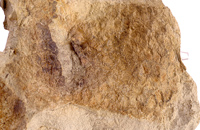 |
RARE DINOSAUR SKIN WITH SOFT TISSUE. Dinosaur skin is the rarest and most coveted of dinosaur fossils because of its extreme rarity being preserved only under extraordinary conditions. The dinosaur had to have been completely covered by fine mud sediments probably in a large river delta within a day or so after dying to avoid bacterial breakdown of the skin and soft tissue which would occur immediately. This type of extreme condition may have occurred in a massive flood. The skin texture was impressed in detail in the soft clay forming a natural mold which was later filled by more muddy sand creating a natural cast and remained intact for over 65 million years even after the skin and other soft tissue was destroyed by bacteria. This large section of dinosaur skin is from an Edmontosaurus duckbilled dinosaur and is between 65-70 million years old and was found along with some fragmented Edmontosaurus bones in the Hell Creek Formation of Montana. Also, soft tissue has also been fossilized along with the skin. The soft tissue could be muscle or glands but it is impossible to say for certain because it is not known what part of the duckbilled dinosaur this skin section came from. The answer might be coming soon as a more complete Edmontosaurus with soft tissue has been found and was featured on a National Geographic Show titled "Dinosaur Autopsy " with a book coming out later this year.
This large section of matrix is 10.5 x 7 inches and has skin impressions on both sides of the limestone rock. The best detailed skin is 4 x 3 inches showing excellent detail with a large 8X1 inch section curving beneath it. Also present which was just below the skin layer when the dinosaur was alive is a 2.5 x 2 inch section imprint of the muscle or gland that was present. On the back of the slab is an 8 inch long skin impression area that varies in thickness from 1-3 inches. All of the color is original just as found when the rare specimen was broken out of a larger piece of rock. The Dinosaur Autopsy show called their find the most important of the decade and an offering of dinosaur skin with soft tissue preservation may never be offered for sale again.
Add $25 for domestic shipping.
Estimated Value $1,250 - 1,500.
View details and enlarged photo
| Unsold |
Lot 461 |
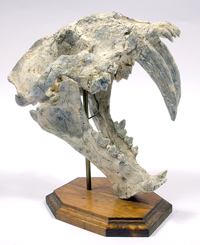 |
SABER TOOTHED CAT SKULL. Perhaps next to a T-Rex, the most popular fossil is that of a Saber Toothed Cat, particularly the skull with its lethal saber-like teeth. In May of this year a complete Smilodon skull from the famous LaBrea tarpit area brought over $330,000. This exquisite 9 inch long skull belongs to the closest know ancestor of Smilodon, Megantereon nihowanensis of the Gansu Province ofCentral Asia. While Smilodon is only 15,000-50,000 years old, Megantereon is 5 to 6 million years old. This skull is completely natural with excellent crème color bone quality and all natural teeth including the all important intact giant sabers that are 3.75 inches long around the curve. Just like Smilodon, the saber teeth of Megantereon were long and very thin and would have broken if they bit down on solid bone. They were most likely used to rip the throat of the prey animal or rip at its stomach. The lower mandible was missing when this skull was found and has been cast from another specimen by a paleontologist and perfectly matched in color and texture with the museum quality skull. With the real lower mandible, specimens of Megantereon have sold for more than $20,000. This is an opportunity to acquire a rare and in great demand saber-toothed cat skull for a very reasonable price.
Add $85 for domestic shipping.
Estimated Value $7,000 - 10,000.
View details and enlarged photo
| Unsold |
Lot 462 |
 |
SPINOSAURUS FOOT CLAW, TOE BONE AND TOOTH. Made famous in "Jurassic Park III" as the dinosaur that killed a T-Rex, the enormous theropod dinosaur Spinosaurus with a huge sail on its back remains an enigmatic dinosaur as no even remotely complete skeleton has been found and the only partial skeleton was destroyed in World War II. Spinosaurus is mostly known from its teeth which are fairly common but usually broken and ugly. Claws are rarely found and big claws such as the 3.6 inch complete museum quality foot claw showing all of the bold grooves with a perfect tip and no restoration plus a 2 inch phalange are usually only seen in museums. Claws are much rarer than teeth because dinosaurs could replace their teeth but not their claws. Also included is an excellent quality 3.6 inch long tooth with excellent brown enamel, a partial root with just a little tooth wear (this occurred when the dino was alive) on the tip. This 80 million year old dinosaur claw and tooth were found in the Kem Kem Valley near Taouz, Morocco. These museum quality fossils are housed in a 86 inch Riker mount.
Estimated Value $1,500 - 2,500.
View details and enlarged photo
| Unsold |
Lot 463 |
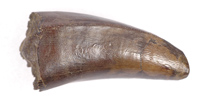 |
T-REX PRE-MAXIALARY 2 INCH TOOTH. Virtually all T-Rex teeth found are shed teeth that broke off when the T-Rex was feeding on some other dinosaur. Usually these teeth are just fragments or are broken into many pieces, but this large 2 inch Pre-Maxilary tooth is the exception.
There is no restoration to this magnificent tooth with the enamel surface being smooth with no cracks and very good serrations. There is some wear on the enamel at the tip that occurred when the T-Rex was still alive. This is a large Pre-Maxilary tooth as the Pre-Maxilary teeth are smaller than the teeth further back in the jaw and were used to strip meat from the bone. They are very distinctive in having two rows of serrations close together on the inner curve of the tooth versus having one row of serrations on the opposite sides of the regular teeth. This 65 million year old treasure was found on a private ranch in the Hell Creek Formation of Montana and is displayed in a 5.5 x 4.5 inch Riker Mount.
Add $20 for domestic shipping.
Estimated Value $2,500 - 3,000.
View details and enlarged photo
| Unsold |
Lot 464 |
 |
TERMITE COLONY AND WOOD IN YOUNG COLOMBIAN AMBER. Amber is the fossilized tree resin. Some trees produce resins to help heal breaks and gashes. Occasionally insects become trapped in the sticky amber and are mummified (dessicated) with incredible preservation of soft tissues, muscles, microscopic detail and sometimes even color. DNA has been retrieved from amber over 65 million years old at the time of the dinosaurs. The age of amber itself cannot be determined. Only the rock it is deposited in can be tested. Colombian young amber is found mostly in the Andes mountains in remote regions and has not been properly dated. The amber with the classic golden honey color like Dominican Amber is probably between 1- 5 million years old. Such is the probable age of this extremely large 13 x 2 inch clear amber nugget weighing 260grams. This magnificent clear piece contains more than 100 termites, termite larvae and two twigs 9-10 inches long swarming with both termites and larvae. There must have been a termite mound beneath this pine tree millions of years ago and a long portion of the mound was covered and trapped in the sticky resin when the tree was injured This rich golden amber nugget is both beautiful and massive with excellent detail of the termites and activity with some of the termites carrying larvae.
Add $15 for domestic shipping.
Estimated Value $500 - 700.
View details and enlarged photo
| Realized
$676 |
Lot 465 |
 |
THREE CARCHARODON SHARK'S TEETH. Carcharodon megalodon was the largest shark that ever lived growing to more than 50 feet long, perhaps much more. Megalodon ate whales whose vertebrae and teeth are often found along with megalodon teeth. These large and impressive teeth are about 15 million years old and are found in up to 120 feet deep water 15 miles off the coast of South Carolina by intrepid divers who have to locate the teeth by feel since there is no visibility at the ocean bottom. There are three perfectly matched 3.25 inch long teeth (measured along the diagonal) each completely original as found with good serrations, root, and enamel with just a minor chip or two. Intact teeth are quite scarce as the vast majority of teeth found are just broken fragments. Housed in a 14 x 8 inch Riker mount.
Add $15 for domestic shipping.
Estimated Value $400 - 600.
View details and enlarged photo
| Unsold |
Lot 466 |
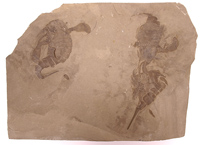 |
THREE EURYPTERIDS, SEA SCORPIONS. Eurypterids, also known as sea scorpions, were fierce predators in the warm seas 425 million years ago. They grew to over 6 feet long and easily hunted the slow moving armored fish of that era. Eurypterids were related to scorpions and were probably the first animal to leave the sea and crawl out on dry land. These three highly detailed sea scorpions, Eurypteurus remipes come from the famous 425 million year old Fiddler's Green Quarry of Herkimer County, New York. The largest complete specimen is 5 inches long having both paddles, telson (looks like the stinger in a scorpion but was not poisonous) and two of the six walking legs. The other two Eurypterids are 3.5- 4.5 inches long and are fairly complete each missing one of their paddles and one having only a partial telson, but both having several well detailed feather-like walking legs. The delicate walking legs are rarely preserved and all three of these Eurypterids are above average and nicely displayed on a 11 x 8 hard gray matrix.
Add $25 for domestic shipping.
Estimated Value $1,200 - 1,500.
View details and enlarged photo
| Unsold |
Lot 467 |
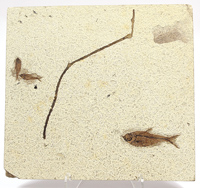 |
THREE FISH AND A BRANCH. From the famous dry 52 million year old lake beds of Green River, Wyoming, this large 19 x 13 limestone plate contains three Knightias and a foot long twig from an unidentified tree. The twig is quite rare as plants are rarely found with the more common fish. The largest Knightia is 4 inches long and excellent and the two small complete Knightias are each 1.75 inches long. Overall the display is esthetically pleasing.
Add $15 for domestic shipping.
Estimated Value $150 - 250.
View details and enlarged photo
| Unsold |
Lot 468 |
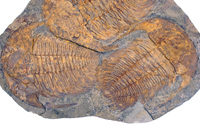 |
THREE GIGANTIC TRILOBITES. This magnificent museum quality slab 25 x 23 inches contains three of the largest trilobites that ever lived. Even more remarkable, these Paradoxites sp. trilobites were some of the very first trilobites that ever lived more than 500 million years ago. These gigantic trilobites were one of the largest predators of the mid Cambrian warm seas of Morocco. The largest of these beasts is 14 inches long and 12 inches in diameter. The other two specimens are 13 inches long. Found in the Atlas Mountain range of Morocco, these trilobites are the original rust orange color (limonite) and have not been painted to cover up restoration. They are virtually complete with only minor restoration of a few of the spines mostly on the pygidiums. Such a spectacular grouping of large trilobites is extraordinary.
Add $75 for domestic shipping.
Estimated Value $1,200 - 1,500.
View details and enlarged photo
| Unsold |
Lot 469 |
 |
TRICERATOPS BROW HORN. Triceratops with its two long brow horns and living at the same time as T-Rex is one of the most popular dinosaurs. This 24 x 7 inch brow horn is very large and from a mature Triceratops. The horns of a Triceratops are never found without cracks and are usually found in pieces. This is an excellent dark well detailed brown specimen that was found in two pieces with a complete tip needing just some minor restoration to repair some cracks. There was a six inch section between the two pieces that was missing and has been restored by a paleontologist and mached perfectly. The grooves in the horn represent areas where blood flowed to the horn. This is a horn core. In life the horn would have been covered with keratin (like our fingernails) and would have been about 30% larger. This excellent large and heavy display fossil is 65-66 million years old and was found a private ranch in Montana.
Add $45 for domestic shipping.
Estimated Value $2,000 - 2,500.
View details and enlarged photo
| Realized
$1,704 |
Lot 470 |
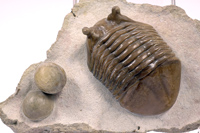 |
TRILOBITE WITH EYE STALKS. Some of the best preserved and most beautiful life-like trilobites come from Wolchow river streams near St. Petersburg, Russia. This exceptionally large outstretched 4.5 x 3 inch 450 million year old trilobite Asaphus kotlukovi is one of the largest found and has two strange extended eye stalks which would stick out of sea bottom when it buried itself to hunt prey animals and protect itself from predators. Also contained on the 9 x 6 inch natural limestone matrix are two strange echinoderms related to the starfish. These two, one-inch diameter balls were attached to the sea bottom with stems looking something like a round sea urchin on a stick. One of the specimens clearly displays the 5 fold symmetry of starfish with irregular hexagonal plates being visible in transparent calcite on the top of the ball. Just the huge Asaphus alone makes this very valuable to collectors but the addition of the echinoderms makes it a museum specimen.
Add $25 for domestic shipping.
Estimated Value $1,200 - 1,500.
View details and enlarged photo
| Unsold |
Lot 471 |
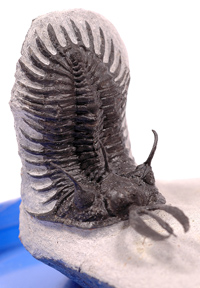 |
WALLISEROPS TRIDENT TRILOBITE. Walliserops is one of the more bizarre of the spiny trilobites of Morocco. What makes it so strange is the trident shaped appendage on the front of its head. What this was used for is pure conjecture with digging in the soft ocean sand being the most likely. The highly detailed professional preparation on this complete 3 x 1 inch 380 million year old trilobite from Ikelel Gara, Southern Morocco is as good as it gets with a 3D trident prepared in a life-like position looking as though it is crawling over a rock, with excellent detail on the long curved spines on the backs of its compound eyes, the small individual lenses of the compound eyes and the one inch long trident. This magnificent weird looking black trilobite is nicely displayed on its original 3 x 2.5 inch smoothed cream colored matrix.
Add $15 for domestic shipping.
Estimated Value $800 - 1,000.
View details and enlarged photo
| Unsold |